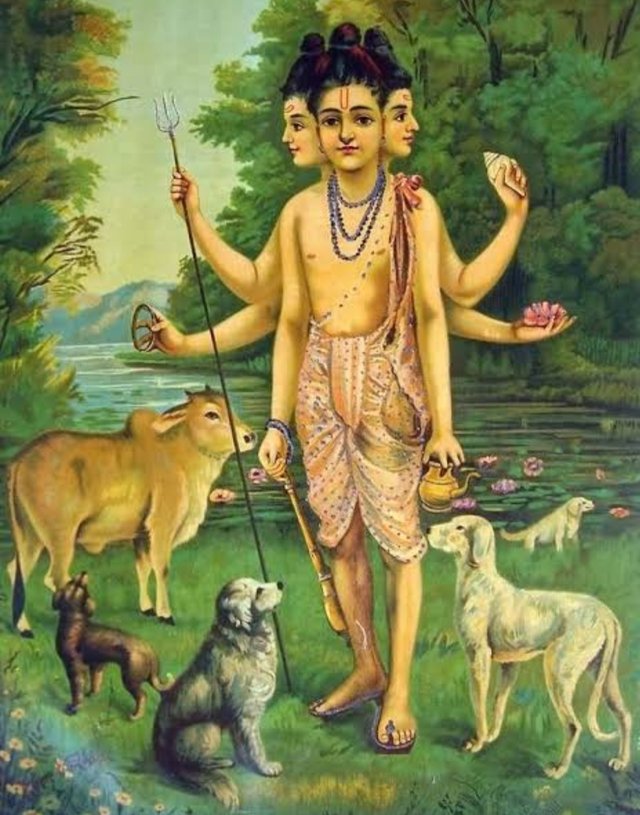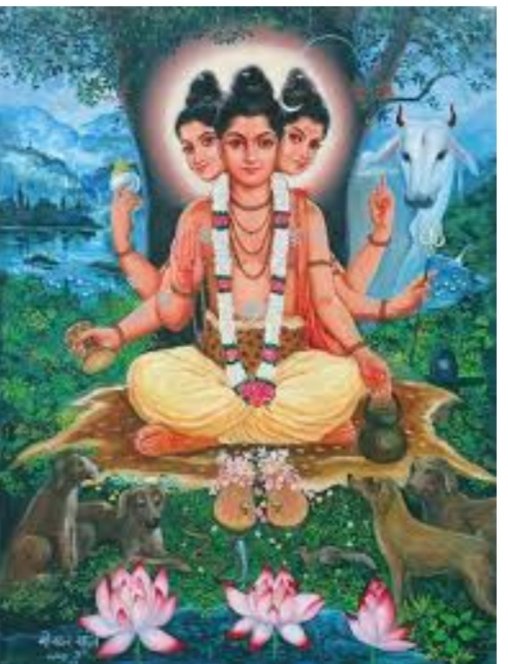Hi friends,
Welcome to my post
Today i like to share a topic of Dattatreya.
Dattā or Dattaguru, is a paradigmatic Sannyasi (monk) and one of the lords of Yoga, venerated as a Hindu god. In Maharashtra, Goa, Andhra Pradesh, Telangana, Karnataka, Gujarat, and Madhya Pradesh he is a syncretic deity, considered to be an avatar of the three Hindu gods Brahma, Vishnu and Shiva, collectively known as Trimurti. In other regions, and some versions of texts such as Garuda Purana, Brahma Purana and Sattvata Samhita, he is an avatar of Lord Vishnu only.Several Upanishads are dedicated to him, as are texts of the Vedanta-Yoga tradition in Hinduism. One of the most important texts of Hinduism, namely Avadhuta Gita (literally, "song of the free soul") is attributed to Dattatreya. Over time, Dattatreya has inspired many monastic movements in Shaivism, Vaishnavism and Shaktism, particularly in the Deccan region of India, south India, Gujarat, Madhya Pradesh, Rajasthan and Himalayan regions where Shiva tradition has been strong.His pursuit of simple life, kindness to all, sharing of his knowledge and the meaning of life during his travels is reverentially mentioned in the poems by Tukaram, a saint-poet of the Bhakti movement.

According to Rigopoulos, in the Nath tradition of Shaivism, Dattatreya is revered as the Adi-Guru (First Teacher) of the Adinath Sampradaya of the Nathas, the first "Lord of Yoga" with mastery of Tantra (techniques), although most traditions and scholars consider Adi Nath an epithet of Lord Shiva.According to Mallinson, Dattatreya is not the traditional guru of the Nath Sampradaya, he was coopted by the Nath tradition in about the 18th century as a guru, as a part of Vishnu-Shiva syncretism. This is evidenced by the Marathi text Navanathabhaktisara, states Mallinson, wherein there is syncretic fusion of the Nath Sampradaya with the Mahanubhava sect by identifying nine Naths with nine Narayanas.

Dattatreya iconography varies regionally. In Maharashtra, for example, he is typically shown with three heads and six hands, one head each for Brahma, Vishnu and Shiva who represent the Trimurti, the 3 main gods in Hinduism, and one pair of hand holding the symbolic items associated with each of these gods: japamala and water pot of Brahma, conch and discus of Vishnu, trident and drum of Shiva.He is typically dressed as a simple monk, situated in a forest or wilderness suggestive of his renunciation of worldly goods and pursuit of a meditative yogi lifestyle. In paintings and some large carvings, he is surrounded by four dogs and a cow, which is a symbolism for the four Vedas and mother earth that nourishes all living beings.In the temples of southern Maharashtra, Varanasi and in the Himalayas, his iconography shows him with one head and two hands with four dogs and a cow.
if you want to know more Knowledgeable post Keep Supporting, 🙏
Happy Dutta Jayanti to you too. I hope you have taken the darashan by visiting the nearby dutta mandir.
#affable #india
Downvoting a post can decrease pending rewards and make it less visible. Common reasons:
Submit
You have shared interesting story of the ancient time. It's quite amazing to learn it.
Keep sharing such posts.
#club5050
Downvoting a post can decrease pending rewards and make it less visible. Common reasons:
Submit
Thanks keep suporting yr
Downvoting a post can decrease pending rewards and make it less visible. Common reasons:
Submit